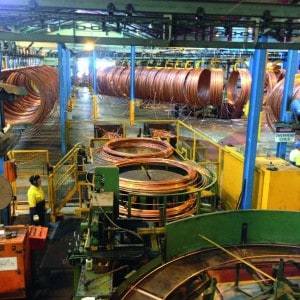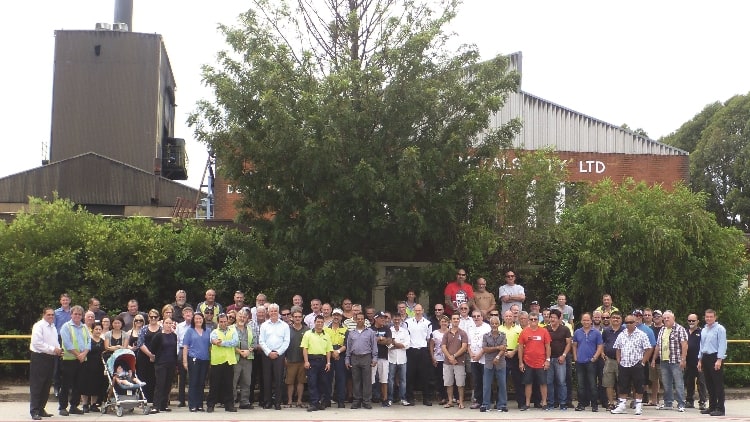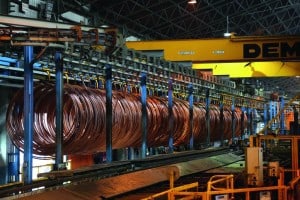Crane Copper Closes its Doors
The Crane Copper Tube factory in Penrith ceased manufacturing and domestic trading at the end of 2014 and is transitioning out of export trading. The closure marks an end of an era. Plumbing Connection looks back over the history of a company long associated with manufacturing innovation in Australia.
Company Beginnings & Early Years
Crane Copper Tube can trace its history back to 1867 when George Ekins Crane established the building supplies firm of G E Crane and Sons in Circular Quay, Sydney.
In 1893 G E Crane & Sons established the Sydney Lead works which operated until 1930 and was known for converting pig iron from Broken Hill into lead sheet, pipes, wire, rods, bars, sash weights and glazing lead.
The Crane business continued as a family business for 41 years until 1908 when conversion to company status was made.
At this time it was known for its own building lines, ornate stamped steel ceilings, sheet metal manufacturing and wrought ironwork.
In the First World War years the Crane Company expanded its plant and machinery and commenced making collapsible metal tubes.
Following the war, the company expanded its metal work to include plumbers’ brassware and copper sheet manufacture.
The Depression years (1929-1935) interrupted the rapid rate of progress but the business avoided operating losses during these grim years by producing lead, guttering and down pipes, copper sheet, aluminium tools and dies and aerosol cans.
In 1937 the company acquired a majority interest in C.O.N Pty Limited located in Brisbane. This gave G E Crane control of a major manufacturing plant for high and low-pressure plumbers’ brassware supplying the Queensland market.
War Years and Manufacturing Innovations
At the outbreak of World War II, G E Crane & Sons had almost completed the installation of a non-ferrous metal rolling mill at its Concord site. The role of this plant was changed through the war effort and, at the Government’s request, G E Crane and Sons became the first company in Australia to roll aluminium sheet for aircraft production. This pioneering role was the beginning of the modern aluminium industry.
Four years after WWII, G E Crane & Sons Limited converted to a public company and its shares were first listed on the Australian Stock Exchange in 1949. The first directors of the company were four of founder George Ekin’s oldest sons – Frederick, Henry, Alfred and Walter. Walter took on the position of managing director of the Sydney Lead Works.
In June 1961, Crane Enfield Metals Pty Limited, a jointly-owned company by the G E Crane group and Enfield Rolling Mills of England was formed at Concord to produce copper tube for the plumbing industry. Rapid growth brought about this company’s move to Crane Copper Tubes current location at Penrith. The plant was expanded to include an aluminium extrusion plant in 1964.
Further expansion came in 1971 with the addition of a 3000 tonne copper alloy extrusion press and integrated cold drawing equipment.
Product Innovations & A Global Approach
In more recent times, Crane Copper Tube developed a global reputation as an innovative, dependable and high-quality producer. The company manufactured copper tube to Australian, New Zealand, British, European and American standards for:
-Water supply
-Drainage and sanitation
-Gas reticulation
-Refrigeration
-Heating and Air Conditioning
-Electrical componentry
-Automotive Instrumentation
-Medical gases
-General engineering
Its focus on the global market received a boost in 2006, when Crane Copper Tube partnered with the German-made Viega Group to release Viega Propress – a press-fit joining system for copper tube – to the Australian market.
In recognition of its world-class manufacturing, Crane Copper Tube held the third party accreditation to AS/NZS ISO 9001:2000 quality systems for production and installation as well as Australian Standards mark and other product certification licences.
Further recognition of quality came in 2005, when a number of employees gained a Certificate III in Competitive Manufacturing. This qualification focused the company culture on creating customer value.

Present Day
Parent company Fletcher Building announced the closure of Crane Copper Tube in September 2014 citing years of unprofitability due to overcapacity of copper tubing, increasing substitution of copper tubing with other materials such as plastic composites.
Fletcher Building Chief Executive Mark Adamson said the decision to cease trading was not made lightly. “We would like to acknowledge all the Crane Copper Tube employees whom in recent years have been relentless in their efforts to reduce operating losses.”
Crane Copper Tube is currently transitioning out of export trading. Meanwhile, Fletcher Building has been working with employees to help find redeployment opportunities.
The Penrith site will remain in Fletcher Building ownership once the plant and other assets are sold or removed. Mr Adamson thanked Crane employees past and present for their contribution to the business.


